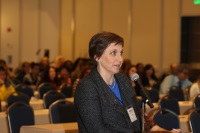June 20
Health Literacy Insights for Public Health Practice: 3 Case Studies in Disaster Management & Relief Efforts
0 comments
June 20
0 comments
 Description
DescriptionHealth literacy research and practice over these last two decades are enabling us to enrich the clinical encounter, transform health care settings and, hopefully, remove barriers to care and services. It is time however, to adopt and adapt these insights for public health practice. This presentation focuses on three case studies [anthrax, a hurricane, and a tsunami] related to disaster management illustrating the critical value of health literacy inquiry and application of findings.
Rima Rudd, Sc.D
Senior Lecturer on Health Literacy, Education, and Policy, Harvard School of Public Health
We have to think outside the box to help with:
Preparedness, community health and safety and disaster management
Anthrax-laced letters sent to people in communications. We needed to communicate the nature of the substance, risk, health implications, treatment, preventive action. There were problems in the clearance system, rumors, misspeaks, and leaks.
A postcard was sent to all households by the Postmaster General for immediate precautionary action. The language used was uncommon and calls to action were vague and abstract. The design was not great either. The case study identified these needs:
National disaster compounded by political neglect.
They needed basic information.
The available materials were not suitable for the general public. (From HHS, CDC, etc.) They paid no attention to health literacy.
Len and Ceci Doak coordinated a volunteer effort with CDC to prepare accessible information with a 6-24 hour turnaround from submission of originals, and pilot test where possible.
The first responders improved the clarity of the information.
Lessons learned:
This was a multi-level disaster. Many people left the city, including families with children, but most people were still there. The Public Health Nurses were left to deal with the population. The nurses had difficult scientific info they could not adequately translate. The result was loss of trust and worsening of the situation. The nurses needed to get a glossary of terms and improved health communication skills. Skills were improved; systemic barriers were uncovered for the nurses to engage in the work they need to do.
Lessons learned:
Insights:
Mechanisms for Change
We need training programs to assess health information and prepare health information. Not just written materials.
We need tools for calibrating math demands, assessing risk communication, assessing entry forms and documents for evaluations and research.
We need studies for communicating to the next level of the public: science, risk, reporting medical and scientific findings, displaying findings, reporting test and study results.
WE HL experts need to work together with other organizations such as volunteer orgs, first respondrs, CDC, FEMA, etc.
“The word is as important as any tool.”
Tags